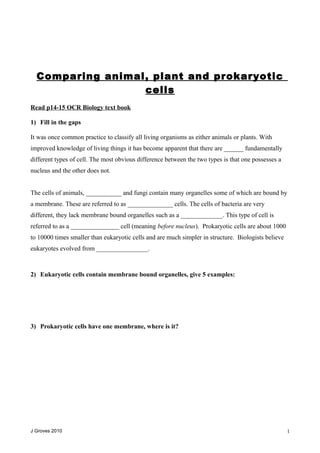
Comparing prokaryotic and eukaryotic cells
- 1. Comparing animal, plant and prokaryotic cells Read p14-15 OCR Biology text book 1) Fill in the gaps It was once common practice to classify all living organisms as either animals or plants. With improved knowledge of living things it has become apparent that there are ______ fundamentally different types of cell. The most obvious difference between the two types is that one possesses a nucleus and the other does not. The cells of animals, ___________ and fungi contain many organelles some of which are bound by a membrane. These are referred to as ______________ cells. The cells of bacteria are very different, they lack membrane bound organelles such as a _____________. This type of cell is referred to as a _______________ cell (meaning before nucleus). Prokaryotic cells are about 1000 to 10000 times smaller than eukaryotic cells and are much simpler in structure. Biologists believe eukaryotes evolved from ________________. 2) Eukaryotic cells contain membrane bound organelles, give 5 examples: 3) Prokaryotic cells have one membrane, where is it? J Groves 2010 1
- 2. 4) Use table 1 to compare plant (eukaryote), animal (eukaryote) and prokaryotic cells. For each cell type indicate whether the feature is present or absent using a tick or cross. Feature Plant cells Animal cells Prokaryote cells Chloroplasts Large permanent vacuole Cellulose cell wall Peptidoglycan (murein) cell wall Linear chromosome Circular chromosome Plasmids Endoplastic Reticulum Golgi body DNA free in the cytoplasm ATP is produced in the mitochondria ATP is produced at infolded regions of the cell membrane called mesosomes Undulipodia contain 9 + 2 circular arrangement of microtubules Flagella made form spiral protein called Flagellin Ribosomes Cell membrane 5) Give 2 ways in which prokaryotes are useful to humans 6) Mitochondria and chloroplasts contain small loops of DNA similar to the plasmids found in prokaryotic cells. These organelles also contain ribosomes that are the same size as prokaryotic ribosomes. Can you suggest an explanation for these features? J Groves 2010 2